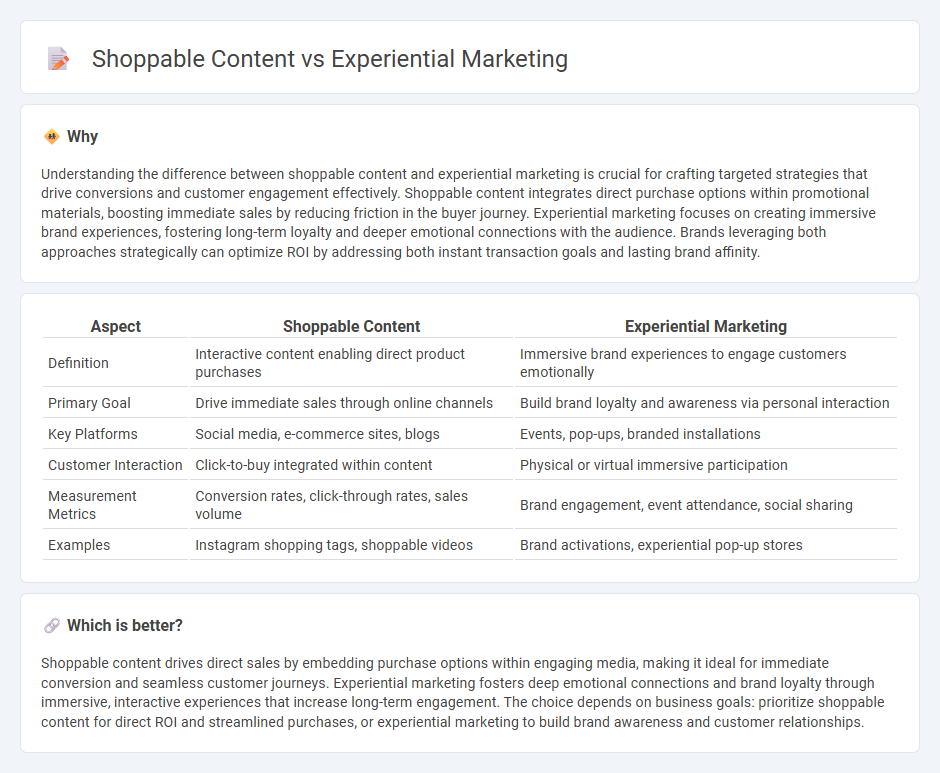
Shoppable content integrates direct purchasing options within digital media, streamlining the customer journey from discovery to transaction by embedding product links in videos, images, or articles. Experiential marketing focuses on creating memorable, immersive brand experiences that engage consumers emotionally and physically, fostering deeper brand loyalty beyond traditional advertising. Explore the strengths and strategic applications of both approaches to enhance your marketing campaigns.
Why it is important
Understanding the difference between shoppable content and experiential marketing is crucial for crafting targeted strategies that drive conversions and customer engagement effectively. Shoppable content integrates direct purchase options within promotional materials, boosting immediate sales by reducing friction in the buyer journey. Experiential marketing focuses on creating immersive brand experiences, fostering long-term loyalty and deeper emotional connections with the audience. Brands leveraging both approaches strategically can optimize ROI by addressing both instant transaction goals and lasting brand affinity.
Comparison Table
| Aspect | Shoppable Content | Experiential Marketing |
|---|---|---|
| Definition | Interactive content enabling direct product purchases | Immersive brand experiences to engage customers emotionally |
| Primary Goal | Drive immediate sales through online channels | Build brand loyalty and awareness via personal interaction |
| Key Platforms | Social media, e-commerce sites, blogs | Events, pop-ups, branded installations |
| Customer Interaction | Click-to-buy integrated within content | Physical or virtual immersive participation |
| Measurement Metrics | Conversion rates, click-through rates, sales volume | Brand engagement, event attendance, social sharing |
| Examples | Instagram shopping tags, shoppable videos | Brand activations, experiential pop-up stores |
Which is better?
Shoppable content drives direct sales by embedding purchase options within engaging media, making it ideal for immediate conversion and seamless customer journeys. Experiential marketing fosters deep emotional connections and brand loyalty through immersive, interactive experiences that increase long-term engagement. The choice depends on business goals: prioritize shoppable content for direct ROI and streamlined purchases, or experiential marketing to build brand awareness and customer relationships.
Connection
Shoppable content integrates seamless purchase options directly within engaging media, enhancing consumer interaction and driving immediate sales. Experiential marketing creates immersive brand experiences that foster emotional connections, increasing the effectiveness of shoppable content by making products more relatable and desirable. This synergy boosts conversion rates by combining interactive storytelling with convenient buying pathways.
Key Terms
**Experiential Marketing:**
Experiential marketing engages consumers by creating immersive brand experiences that foster emotional connections and memorable interactions. It emphasizes direct participation, sensory involvement, and storytelling to build brand loyalty and drive word-of-mouth promotion. Discover how experiential marketing strategies can elevate your brand presence and customer engagement.
Brand Activation
Experiential marketing drives brand activation through immersive, face-to-face interactions that create memorable consumer experiences, enhancing emotional connections and long-term loyalty. Shoppable content integrates direct purchasing options within engaging digital media, streamlining the path from brand awareness to conversion by merging content consumption with e-commerce. Explore how harnessing both strategies can amplify brand activation and customer engagement.
Immersive Engagement
Experiential marketing creates immersive brand interactions through live events and sensory experiences that foster emotional connections and memorable engagement. Shoppable content integrates product purchasing within interactive media, blending entertainment and seamless e-commerce to drive instant conversions. Explore how combining immersive engagement techniques enhances customer experience and boosts brand loyalty.
Source and External Links
Experiential Marketing: How To Create Immersive Brand Experiences - Experiential marketing is a strategy that engages consumers interactively by inviting them to participate in memorable, immersive brand experiences like pop-up shops and live events to build emotional connections and long-term loyalty, differing from traditional marketing by focusing on brand awareness rather than direct KPIs.
What Is Experiential Marketing? - Experiential marketing engages consumers through live, immersive experiences such as events, pop-ups, and product demos that transform passive audiences into active participants, fostering personalized emotional connections with the brand while also gathering valuable consumer insights.
Engagement marketing - Experiential marketing involves creating custom memorable experiences that engage the senses and emotions to create strong consumer attachment and competitive differentiation, using a strategic process including experience audit, brand platform creation, and performance monitoring to ensure brand loyalty and effectiveness.
 dowidth.com
dowidth.com